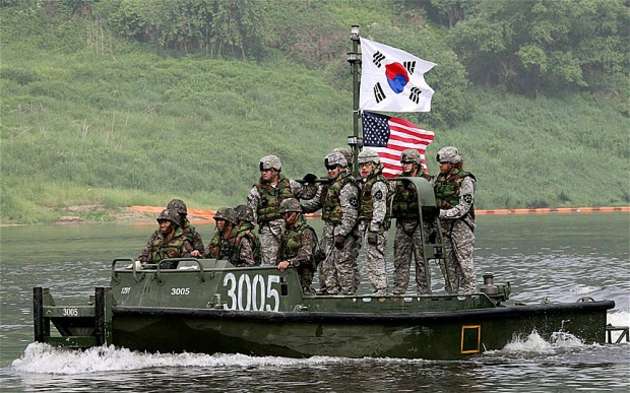The US and South Korean large-scale combined joint exercise Ulchi Freedom Guardian (UFG) begins on Aug. 21 to last till Aug. 31. There will be approximately 17,500 total US service members participating, with roughly 3,000 coming from off-peninsula – 500 more than last year. The numbers of all participants swell to a total of about 530,000 because South Korean servicemen (around 50,000), government officials and civilians also take part in the drills. The missions include: amphibious landings, intense live-fire exercises, counter-terrorism drills and simulated or tabletop battle plans.
Russian Foreign Minister Sergei Lavrov said that Moscow was deeply worried and considered the risk of military conflict between the US and North Korea “very high.” He suggested a plan under which North Korea would halt missile tests if the US and South Korea would cancel the drills. China also objects to the exercise.
The UFG training event was initiated in 1976 and is conducted annually during August or September. This year, it is the first UFG exercise to be held after Pyongyang fire-tested intercontinental ballistic missiles capable of striking US territory, such as the island of Guam. North Korea feels threatened by a squadron of B-1B bombers on the island. The aircraft flying to the peninsula for taking part in the exercise could provoke it into launching ballistic missiles to spark a war. Last year, Pyongyang responded to the UFG by testing a nuclear weapon.
North Korea alleges that the drill is a precursor to a war planned against it. With bits of information coming from various sources pieced together, one can come to conclusion that this time it may be right. It’s not a routine training event.
This year, the scenario includes training for “decapitation strikes” to kill North Korean leader Kim Jong Un and his top lieutenants. It makes the North Korean leadership increasingly sensitive to the event.
The drills take place right after the new sanctions against North Korea went into effect. President Trump signed the Countering America’s Adversaries Through Sanctions Act into law on August 2. According to the data received from US satellites, North Korean missile launchers had been moved into positions ready to strike Guam. The possibility of escalation is made even more acute by the lack of any means of official communication across the demilitarized zone.
Australia has decided to join the training event. Last week, Prime Minister Malcolm Turnbull confirmed his country would join the US in any conflict with North Korea if it carries out its threat to fire missiles towards Guam. Tokyo has moved a ballistic missile defense (BMD) capable destroyer into the Sea of Japan. It has also deployed four land-based defence systems in case US interceptors failed to hit any North Korean missiles. Canada, Columbia, Denmark, New Zealand, the Netherlands and the United Kingdom, will also participate in the exercise.
The question now is why should the US send more forces to South Korea, with about 30,000 combat ready troops already stationed in that country? American servicemen are also deployed in Japan. The number of American troops to take part in the exercise is over 17,000, the Pentagon has 28,500 already in place, then why spend money, time and effort to transport more forces from the continental USA?
According to the tweet posted on August 19 by the source named Already Happened, US military loaded around 1,500 military vehicles including Stryker AFVs onto USNS Bob Hope and Cape Isabel vehicle cargo ships in WA, West Coast. The information is supported by photos. Before that, long trains loaded with US Bradley IFVs and other vehicles had been spotted in Houston, TX. Already Happened provided videos to confirm the report.
Marine Corps Gen. Joseph Dunford, chairman of the Joint Chiefs of Staff, has just wound up his Asia trip, visiting South Korea, China and Japan. According to him, a “full range” of contingency plans had been drawn up in case diplomatic and economic sanctions did not deter Pyongyang’s development of nuclear weapons.
The exercise may hold more potential to provoke a conflict than ever, given the fact that the war game kicks off after North Korea successfully flight-tested two intercontinental ballistic missiles last month and threatened to strike Guam with intermediate range ballistic missiles. The calls to ease the tensions on the Korean Peninsula and give diplomacy a chance have been ignored by the US The training event may provoke Pyongyang into another ICBM test to make the war almost unavoidable. The only thing left is to keep the fingers crossed hoping the worst won’t happen.
Reprinted with permission from the Strategic Culture Foundation.


